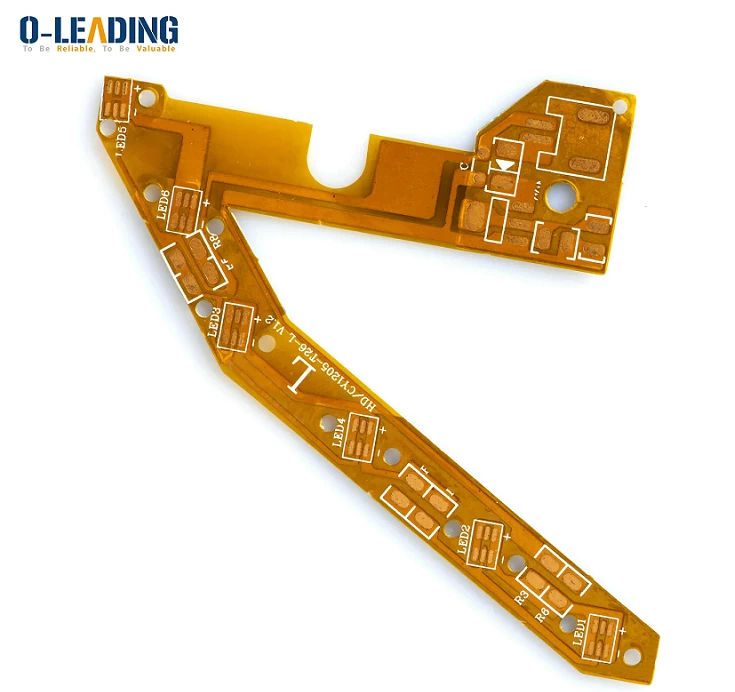Flexible PCB: the difference between single-layer FPC/double-sided FPC/multi-layer FPC
PCBs are used in electronic products, and the PCB market trend is almost the vane of the electronics industry. With the development of high-end and miniaturized electronic products such as mobile phones, notebook computers and PDAs, the demand for flexible PCBs (FPC) is increasing. PCB manufacturers are accelerating the development of thinner, lighter and denser FPCs. Everyone introduces the types of FPC.
1. Single layer FPC
It has a layer of chemically etched conductive pattern, and the conductive pattern layer on the surface of the flexible insulating substrate is rolled copper foil. The insulating substrate may be polyimide, polyethylene terephthalate, aramid fiber ester, and polyvinyl chloride. Single-layer FPC can be divided into the following four sub-categories:

Flexible Printed Circuit Manufacturer PCB
(1). One-sided connection without covering layer
The wire pattern is on the insulating substrate, and there is no covering layer on the surface of the wire. The interconnection is realized by soldering, welding or pressure welding, and is commonly used in early telephones.
(2). One-sided connection with covering layer
Compared with the former, there is only one more covering layer on the surface of the wire. The pad needs to be exposed when covering, and it can simply not be covered in the end area. It is the most widely used and most widely used single-sided flexible PCB. It is used in automotive instruments and electronic instruments.
(3). Double-sided connection without cover
The connection pad interface can be connected on the front and back of the wire. A via hole is opened on the insulating substrate at the pad. This via hole can be punched, etched or other mechanical methods at the desired position of the insulating substrate. to make.
(4). Double-sided connection with covering layer
In the former category, there is a covering layer on the surface. The covering layer has via holes, allowing both sides to be terminated, and still maintaining the covering layer. It is made of two layers of insulating material and a layer of metal conductor.
2. Double-sided FPC
Double-sided FPC has a conductive pattern made by etching on both sides of the insulating base film, which increases the wiring density per unit area. The metalized holes connect the patterns on both sides of the insulating material to form a conductive path to meet the flexible design and use functions. The cover film can protect single and double-sided wires and indicate the location of components. Depending on the requirements, metallization holes and cover layers are optional, and this type of FPC is rarely used.

Good Price 6-Layer Rigid FR-4 Material Automotive Flex FPC Car Flexible PCB Board
3. Multi-layer FPC
Multi-layer FPC is the lamination of 3 or more layers of single-sided or double-sided flexible circuits, through drilling and plating to form metallized holes to form conductive paths between different layers. In this way, no complicated welding process is required. Multilayer circuits have huge functional differences in terms of higher reliability, better thermal conductivity, and more convenient assembly performance.
The advantage is that the substrate film is lightweight and has excellent electrical characteristics, such as low dielectric constant. The multi-layer flexible PCB board made of polyimide film as the substrate is about 1/3 lighter than the rigid epoxy glass cloth multilayer PCB board, but it loses the single-sided and double-sided flexible PCB. The flexibility of most of these products does not require flexibility. Multi-layer FPC can be further divided into the following types:
(1). Finished flexible insulating substrate
This category is manufactured on a flexible insulating substrate, and its finished product is stipulated to be flexible. This structure usually bonds the two ends of many single-sided or double-sided microstrip flexible PCBs together, but the central part is not bonded together at the same time, thus having a high degree of flexibility. In order to have a high degree of flexibility, a thin, suitable coating, such as polyimide, can be used on the wire layer instead of a thicker laminated cover layer.
(2). Finished soft insulating substrate
This category is manufactured on a flexible insulating substrate, and its final product is specified to be flexible. This type of multilayer FPC is made of flexible insulating materials, such as polyimide film, laminated to form a multilayer board, which loses its inherent flexibility after lamination.
































